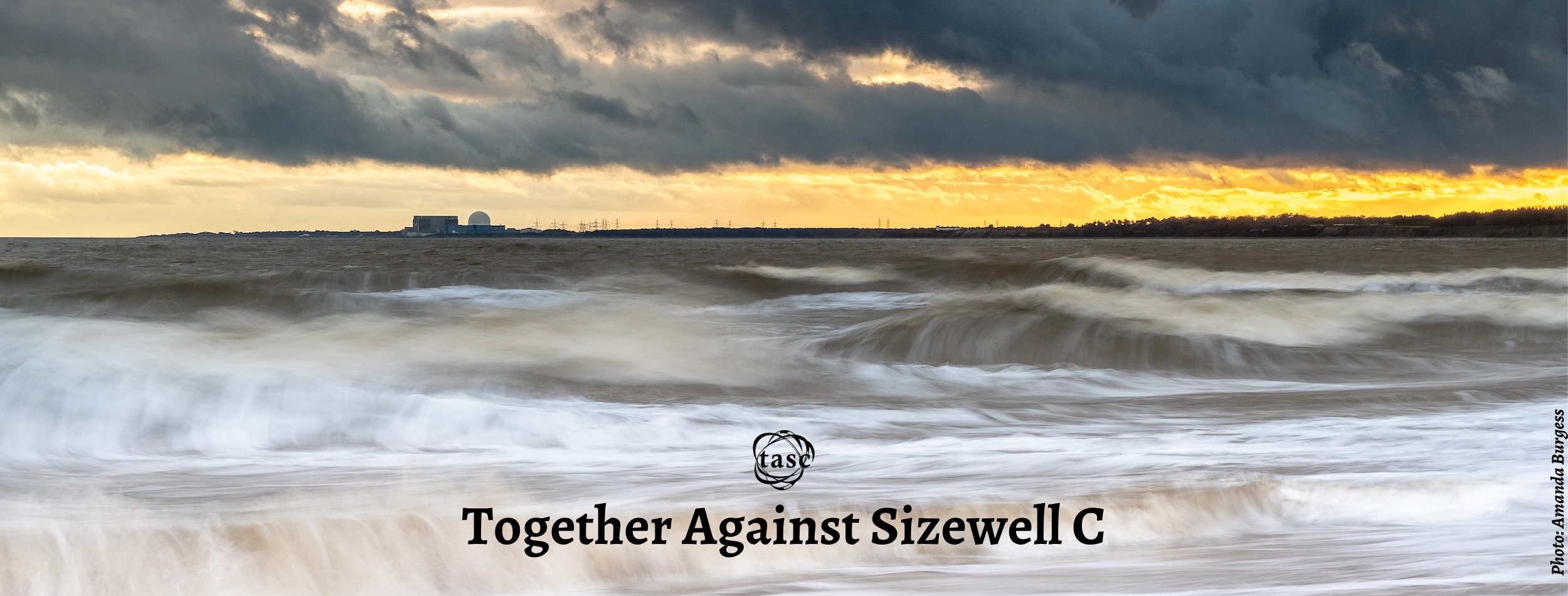TASC Press Release … ‘Seascape’ response in Guardian 28.04.21
TASC PRESS RELEASE
STRICTLY EMBARGOED UNTIL NOON ON WEDNESDAY THE 28TH APRIL 2021
CEFAS TURNS A BLIND EYE TO THE WHOLESALE MASSACRE OF PROTECTED FISH SPECIES DUE TO EDF’S NUCLEAR OPERATIONS AT SIZEWELL
Using figures taken directly from EdF’s own DCO documents[1] for Sizewell C, Together Against Sizewell C (TASC) has calculated the scale of the slaughter of fish which will occur in the event that Sizewell C is approved and operates alongside the existing ‘B’ plant between 2035 and 2055, the assumed start date for Sizewell C and the year in which Sizewell B is now expected to cease operations, assuming it applies for and is granted regulatory approval for the expected twenty year life extension to 2055.
In that twenty year period, an estimated 560 million fish will be sucked into (entrained) and impinged within the cooling systems of both plants, with a toll of 28.5 million fish[2] every year. Sizewell C, taking in 131 cubic metres of seawater per second – 2.5 times that of Sizewell B – will be responsible for 20 million of that number, or over 70% of the total.
But this staggering figure hides a grim truth: it represents only a percentage of the overall impact on the marine environment inflicted by nuclear power. Unknown millions of eggs, marine crustaceans, larvae and post larval stages of fish fry along with other marine biota are entrained through the nuclear plant cooling systems every year, adding to the toll of those impinged on the mesh of the cooling intakes and the decimation of fish stocks.
Among the species of fish suffering such a fate are several which are subject to special conservation measures in order to allow the historically depleted stocks to recover. A person fishing from Sizewell beach landing a small number of bass is likely to be prosecuted unless he or she releases the catch. Yet EdF’s operational nuclear power plant, Sizewell B, is responsible for the impingement of over 800,000 bass every year and Sizewell C is expected to take over 2,000,000 bass a year should it ever become operational: the Centre for Environment, Fisheries and Aquaculture Science (Cefas) in Lowestoft has not, to the knowledge of TASC, voiced its concerns at these staggering statistics, bringing into question the role they play in safeguarding the viability of our seas and the fisheries it supports, unsurprising, perhaps since Cefas are working as paid consultants to EdF.
Shad, Blackwater herring, eel and lamprey are other species subject to conservation measures which are entrained in the cooling systems of Sizewell B and will be likewise ensnared in a future Sizewell C, should it ever be built.
TASC points out, however, that the figures used in the attached document which predict the impact of a notional Sizewell C plant, are extrapolations at the lowest level when in reality the true scale of the damage will be much larger because the doubling of the flow intake rate tends to produce a quadrupling of the fish captures. In addition, the impingement estimates are calculated assuming that Sizewell C’s cooling system will employ a 10mm screen, when in fact it is likely that a 5 mm screen will be used, greatly increasing the numbers of smaller fish impinged.
Pete Wilkinson, TASC Chairman, said today, ‘This carnage is wholesale, inhumane and unacceptable and flies in the face of the government’s so-called ‘green agenda’. We expect Cefas to condemn this level of impact at the inquiry stage of the Sizewell C development consent order. Cefas’s stated aim is ‘to help keep our seas, oceans and rivers healthy and productive, and our seafood safe and sustainable…’.Instead, it seems that Cefas appears quite at ease with itself presiding over the deaths of millions of fish and clearly feels the huge number of fish deaths is acceptable in that the overall health of fish stocks will not be compromised.
‘This view ignores the fact that the 28 million fish which Sizewell B and C will jointly cause to be sucked into the cooling systems every year is only the tip of the iceberg. While the loss of millions of mature fish in itself is a cause for great concern, the long term viability of fish stocks in the immediate Sizewell bay area is further endangered by the massive and unknown numbers of fish fry and eggs which are lost to the cooling needs of these plants.
‘The scale of decimation caused by EdF’s activities on our Heritage Coast is not confined to damage to heaths, wetlands and woods and clearly does not stop at the water’s edge nor at the end of the construction period: it extends deep into the North Sea and over many decades, centuries and millennia when the impact of waste management is considered. Tens of millions of fish, crustaceans and other marine biota will be sacrificed for the purposes of cooling a plant which is not needed to keep the lights on, which will do nothing to reduce global carbon emissions, which will be paid for from the pockets of all UK taxpayers and bill-paying customers, leaving future generations with a lasting legacy of an impoverished environment. Continued official silence on these issues will be a dereliction of duty and a national disgrace.’
[1] DCO Document 6.3 Vol.2 Chapter 22 Appendix 22D (appendix C: Predicted Sizewell B Annual impingement from 2009 – 2013 data)
[2] This is the lowest possible estimate: in reality, the figure is expected to be far higher.
PLEASE SUPPORT TASC’s FIGHTING FUND IF YOU CAN. EVERY LITTLE HELPS. THANK YOU
GoFundMe
For further information contact:
Pete Wilkinson. Chairman 01728 660232/07940 524 831
Chris Wilson Press Officer 07976 820524

